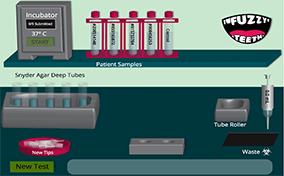What are dental caries?
Dental caries is also called tooth decay and results in the breakdown of the enamel, dentin, and cementum of a tooth. Pain, gum inflammation, infections, and tooth loss can result from dental caries. Diets high in simple sugars along with poor dental hygiene are most often associated with increased occurrences of dental caries.
What causes dental caries?
Although a number of factors are associated with causing dental caries, the presence of increased levels of lactobacilli and oral streptococci, such as Streptococcus mutans are highly correlated with the likelihood of dental caries. These bacteria ferment sugars in the mouth resulting in an increasingly acidic environment. High acid concentrations compromise the enamel, dentin, cementum, and possibly the structural integrity of a tooth possibly leading to a cavity.
What is the Snyder test?
The Snyder test is used to measure the susceptibility of dental caries through the analysis of a patient’s saliva sample. The Snyder test uses an agar medium that has a pH of 4.8 and contains the carbohydrate, glucose. The medium also contains bromocresol green, which is an acid/base indicator that operates in a pH range of 3.8 (yellow) – 5.4 (blue). The table below shows how Snyder test results should be interpreted after a 24–36 -hour incubation period.
What are indicators of susceptibility to dental caries?
While many bacteria cannot survive in a low pH medium, some bacteria thrive in the low pH of the Snyder medium. These bacteria ferment the glucose, which produces even more acidic conditions in the medium generally through the production of lactic acid and lowers the pH. The bromocresol green indicates the lowered pH, which in turn is a measure of the number of the bacteria present in the saliva sample. The greater the number of dental caries causing bacteria in the patient’s saliva sample, the lower the sample’s pH value, and the greater susceptibility to dental caries.
 Have you ever woken up in the morning, run your tongue over your teeth, and felt almost a fuzzy-like feeling on your teeth? That fuzzy feeling was most likely caused by a biofilm or dextran — sticky substances produced by bacteria in your mouth when the bacteria fermented simple sugars you recently ate. Can you use the Snyder test to determine if a patient is susceptible to dental caries?
Have you ever woken up in the morning, run your tongue over your teeth, and felt almost a fuzzy-like feeling on your teeth? That fuzzy feeling was most likely caused by a biofilm or dextran — sticky substances produced by bacteria in your mouth when the bacteria fermented simple sugars you recently ate. Can you use the Snyder test to determine if a patient is susceptible to dental caries?)


